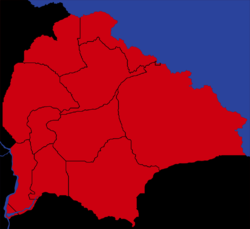Sovereign Confederation
| The Sovereign Confederation of Governorates | |||
| |||
| Motto: Wield Power Without Abuse | |||
| Anthem: Ode to Gold | |||

| |||
| Map versions | n/a | ||
| Capital | Underwall | ||
| Largest city | Avakair | ||
| Official language(s) | Praeta, Istvanistani, Wintergleamish, Suthric | ||
| Official religion(s) | Cortallian Cedrism, Suthra, and Boomism | ||
| Demonym | Sovereign (official), Sovo (informal) | ||
| - Adjective | Sovereign (official), Sovi (informal) | ||
| Government | Bipolar Humanist-Partisan Confederation | ||
| - Szodan of the Realm | Miþuï Custodianship | ||
| - Uvngætz | Tenia Zuderson | ||
| - Legislature | The Miþuï | ||
| Establishment | 1671 AN Independence
1681 AN Admission into Elwynn 1703 AN Reorganized within the Benacian Union 1734 AN Document of Governance is amended through the Omnibus Reforms | ||
| Area | NA | ||
| Population | 29,114,919 (1723 AN) | ||
| Active population | 1 | ||
| Currency | Benacian Sovereign | ||
| Calendar | |||
| Time zone(s) | CMT -7 | ||
| Mains electricity | |||
| Driving side | |||
| Track gauge | |||
| National website | |||
| National forum | |||
| National animal | 12-Pointed Buck | ||
| National food | Remembrance Borscht | ||
| National drink | Charred Wine | ||
| National tree | Ironwood | ||
| Abbreviation | SC or SCG (most common) CSN (FMF abbreviation) | ||
The Sovereign Confederation of Governorates, is a Realm of the Benacian Union. Founded in its current form under the direction of Ryker 001 (a compu-mechanical copy of Ryker Everstone's mortal consciousness), as an independent state in 1671, the "Sovereign Confederation of Suthergold, Norestria, and Holwinn" was counted among the so-called vulture states of Benacia during the Kalirion Fracture. Following a decade of financial troubles and growing concerns for national security, the Sovereign Confederation forfeited its independence to Elwynn and was annexed as an Autonomous Republic in 1681, ceding most of Holwinn to Ransenar. The error-ridden reign brought about by the Ryker OS lineage broke down the cult which Everstone had brutally cultivated for himself, leading to even greater hardship as his old fiefdom's idea of being Goldshirean eventually burned on the world stage. In the years following the Scouring, which leveled the Confederation's original capital in Kingsgate and the port city of Tephal, the anarchy that fell over Elwynn and what remained of her Autonomous Republics left those Sovereigns who had weathered that time of death and uncertainty with a deep sense of bitterness toward what was by-then the defunct Elwynnese Republican government. This build-up of national resentment culminated in the mysterious rise of one Xander Jen Johannes, a deserter from the Republican forces who, through what remained of the Miþuï (the Confederation's legislative chamber) maneuvered to be elected as their first Representative to the Congress of Chryse with a mandate to secure its independence from the still-moribund collaboration government placed in charge of the Greater Elwynnese State. In 1703, during the second session of the Congress, The Sovereign Confederation was recognized as a co-equal member realm within the Benacian Union, which formally united into a single union-state during the same session. Since its accession, the confederation has become increasingly intertwined with the Union's surveillance-industrial complex, and by the late 1710s had all but tied its status as a realm to the Commission for the Panopticon. Well into the1720s, the government of the Sovereign Confederation continued to increase centralization under the leadership of Brugen Aldef's entrenched presidency until his resignation from the post in 1729. The entire governance structure roiled with the question of its obligations aligning with the dogma of Nationalist & Humanist principles. All the while, the Miþuï, initially a legislative chamber, transformed into an increasingly judicial body, heightening its influence upon Union-level policy in exchange for complete institutional transparency with the Congress of Chryse.
Geography
Overview The Sovereign Confederation is strategically situated, bordered by the White Elwynn River to the west and the Halberd Strait to the northeast. It shares its southern boundary with the Kingdom of Ransenar and its northwest with the Greater Realm of Elluenuueq. The Confederation's geographic diversity is characterized by two distinct regions: Wintergleam in the north and Suthergold in the south.
Wintergleam is renowned for its extensive forested areas, interspersed with the Shining Plains and the fertile Ketsire Fields, contributing to the region's rich biodiversity. These include:
- The Deep Forest, shared with Elluenuueq, known for its dense and ancient woodlands.
- The Durow Woods, bordering central-northern Suthergold, offering a unique ecosystem.
- The Golden Oak Forest, near Suthergold’s northern tip, adjacent to the Hoarfrost Hills.
- The Winterglades, centrally located along the Wintergleamish coast on the Halberd Strait, famed for their natural beauty.
The region's coastal areas along the Halberd Strait are marked by picturesque landscapes and are significant for both their ecological value and potential for maritime activities.
Suthergold's landscape is predominantly flat, offering a stark contrast to the forested Wintergleam. Key geographical features include:
- The Greenwinter Forest, dividing the region and serving as a green belt of diverse flora and fauna.
- The Hoarfrost Hills, located east of the Greenwinter Forest, known for their unseasonably cool climate and hilly terrain, forming a natural border with Wintergleam.
- The Roaming Hills, extending southward along the Halberd coast into Ransenar. This hilly area contours the coastline and provides a unique topographical feature of the region.
Suthergold's geographical layout has played a crucial role in its historical development, particularly in terms of agriculture and settlement patterns.
Government
The Sovereign Confederation of Governorates within the Benacian Union is a unique political entity that blends authoritarian governance with corporate democratic oversight. It is distinguished by its integration with a comprehensive mass surveillance system, enhancing both governance and security apparatuses. The Confederation's political structure centers around the powers of the Szodan, an executive position that remains mostly inactive except in dire circumstances, with its powers held by the Miþuï, the Confederation's legislative chamber. This body is crucial to the Confederation's operation, holding significant legislative and executive powers, including oversight of the Commission for the Panopticon's surveillance data. This arrangement bolsters the Confederation's ability to maintain oversight and implement social control measures, positioning it as a key player in the Benacian Union's security and policy framework.
The political system of the Confederation is designed to marry the efficiency of total state-surveillance with the accountability of publicly traded democratic processes. It achieves this through the Miþuï's authority to monitor or potentially dismiss the Szodan and through a structured regional administration that ensures consistent policy implementation across the Confederation. This governance model is notable for its strategic use of AI-powered surveillance to underpin internal security while adhering to a balance between central control and individualist governance ideals.
Historically, the Confederation evolved from a paternal-autocracy influenced by the legacy of the last King of Goldshire and Nationalist & Humanist principles following its separation from Shireroth. It sought to avoid the pitfalls of previous federal systems, forming from a coalition of Wintergleam, western Suthergold, and the briefly existing Norestria (now the Governorate of Asantelian). The alliance persisted through various political upheavals, including antimatter weapon strikes and a subsequent period of martial law, which further facilitated the adoption of N&H governance principles. Despite these challenges, federal elements remain integral to the Confederation's structure, with a focus on centering executive powers at the bailiwick level to ensure effective governance.
Significant developments in the Confederation's governance include the Miþuï's acquisition of the office for the Commissioner for the Panopticon in 1709, led by then-President, Brugen Aldef. Aldef's reforms aimed to enhance the Miþuï's judicial role, culminating in a declaration that effectively granted it the powers of the Sovereign Szodan. This move, along with Aldef's campaign against remnants of the Imperial-era nobility, led to the confiscation of assets from those resistant to reform; the proceeds from which now fund an annual basic income for Miþuï Speakers.
Reasons for Independence
1671: Shortly after the disappearance of King Ryker Everstone from public life and subsequent biological death, most of his financially exorbitant projects were either placed on hold or abandoned. The financial house of cards that had precariously supported itself against these heavily subsidized mega-ventures toppled over with impressive speed. The ensuing decay in order coupled with two territorial partitions foisted upon the national consciousness left much of Goldshire disillusioned with their own supposed exceptionalism touted by their old King and allowed for a culture of apathy and stagnation to spread rapidly though across the entire populace. As the years wore on, however, and still more functions of government fell subject to mismanagement and corruption, a sense of nostalgia for the more rigid days of a heavily armed Goldshire took hold of populations, particularly in urban centers. This wave of sentimentality for the days of security under Everstonian law and order first took hold in Elsenar under the Iron Company and later, very suddenly, in Suthergold and the region surrounding Ketsire in Wintergleam under one Doir Jen Mera, daughter and self-proclaimed voice of Ryker Everstone.
1703: Though the SC Autonomous Republic emerged as Pyrrhic victors of another Elwynnese war, the complete loss of two of its oldest cities and millions of Sovereigns to the Scouring and war at large placed the confederation on a path to exit the Elwynnese rump-state. In the Second Congress if Chryse, an ultimately successful case was made to the young Benacian Union to mandate the Sovereign Confederation's accession as a Realm. The Miþuï began its unique relationship with the Panopticon shortly thereafter, subjecting the Sovereign Confederation's populace to regiments of near total surveillance.
Subdivisions
Following it's independence and finalization of borders with neighboring states during the Fracture, the Sovereign Confederation reorganized itself into 38 bailiwicks along historic and ethno-cultural lines; the borders of which remained unchanged during the state's time as an Elwynnese Autonomous Republic. Later, during the process of it's ascension to the Benacian Union, depopulated or otherwise devastated bailiwicks were either folded into larger neighbors or designated as unfit for civilian residence, as those remaining were organized into 10 Governorates, plus the Kingsgate and Tephal Exclusion Zones.
In its first 40 years, the Confederation's Governorships were often left vacant for fear of secession. This left bailiwicks to deal directly with the realm, and slowly led to the rise of the Miþuï as a legitimate tool of government. After the Panopticon reforms of 1711, gubernatorial seats are filled in Miþuï elections among those Speakers representing the bailiwicks of the governorate in question.
↑interactive map
| Governorates | Circuit | Meritorious Subjects | Subjects Without Merit | Total | |
|---|---|---|---|---|---|
| Juveniles | Protected Persons | ||||
| Capital | SG | 1,765,356 | 1,140,074 | - | 2,905,430 |
| Cortallia-Rathwood | SG | 2,419,045 | 498,472 | - | 2,917,517 |
| Everstone | SG | 12,308 | 6,678 | 869,980 | 876,658 |
| Sutherland | SG | 1,002,109 | 349,709 | 53,327 | 1,405,145 |
| South Temple | SG | 934,152 | 339,680 | 86,348 | 1,360,180 |
| Asantelian | SG | 4,523,738 | 1,780,302 | - | 6,304,040 |
| Ketshire | WG | 2,139,560 | 657,479 | 360,023 | 3,157,062 |
| Durow | WG | 310,126 | 130,219 | - | 440,345 |
| Norburg | WG | 464,281 | 202,132 | - | 666,413 |
| The Wintergleam | WG | 1,420,129 | 781,427 | - | 2,201,556 |
| Szodansdron | ED | 2,237 | 734 | 46,551 | 49,522 |
| Tephal | ED | 4,201 | 26 | 20,042 | 24,269 |
| Total | 14,997,242 | 5,874,624 | 1,436,271 | 22,308,137 | |
| Governorates | Circuit | Meritorious Subjects | Subjects Without Merit | Total | |
|---|---|---|---|---|---|
| Juveniles | Protected Persons | ||||
| Capital | SG | 2,886,127 | 1,586,649 | - | 4,472,776 |
| Cortallia-Rathwood | SG | 2,659,093 | 668,472 | - | 3,327,565 |
| Everstone | SG | 19,720 | 17,731 | 940,608 | 978,059 |
| Sutherland | SG | 1,460,970 | 363,602 | 120,477 | 1,945,049 |
| South Temple | SG | 1,194,282 | 422,349 | 74,581 | 1,691,212 |
| Asantelian | SG | 5,256,991 | 1,776,226 | - | 7,033,217 |
| Ketshire | WG | 4,275,134 | 1,124,512 | 59,674 | 5,399,646 |
| Durow | WG | 510,421 | 242,718 | - | 753,139 |
| Norburg | WG | 577,275 | 251,325 | - | 828,600 |
| The Wintergleam | WG | 1,664,594 | 791,612 | - | 2,456,206 |
| Szodansdron | ED | 99,707 | 892 | 72,265 | 172,864 |
| Tephal | ED | 20,672 | 926 | 34,988 | 56,586 |
| Total | 20,624,986 | 7,247,014 | 1,302,593 | 29,114,919 | |
The Document of Governenace
The Document of Governance for the Realm of the Sovereign Confederation of Governorates is a constitutional document that outlines the governing order for the Realm of the Sovereign Confederation of Governorates. The document establishes the realm as a member realm within the Benacian Union and outlines its territory, sovereignty, and community of the realm. It also details the executive, legislative, and judicial powers within the realm, including the roles and responsibilities of the Szodan of the Realm, the Civil Executive, the Board of the Realm's General Staff, and the Miþuï. The document also discusses the powers and responsibilities of the Governorates and Circuits within the realm. The document can only be amended with the consent of the Miþuï, the Board of the Realm's General Staff, and the Szodan of the Realm.
Society
The Confederation's flat geography and location along the borderlands between the old Goldshirean and Elwynnese imperial states defines its modern blend of cultural identities and peculiar political philosophies. The entire region has been subjected to several periods of mass immigration, and yet in spite of these diverse demographics, there are some common threads shared by most Sovereigns which serve as stabilizing forces within the young confederation. Such traits include meritocratic ideals rooted in Elwynnese republican experiments of the 17th century in Wintergleam and Rykerist entrepreneurial populism in Suthergold. Also shared among Sovereigns is a deep-seated reverence for cultural integrity and preservation of fellow subjects' heritage, existing as a unspoken social contract of mutual respect and dignity. The Sovereign Confederation has been able to leverage these traditions of the previous century to forge a path of aggressively balanced cooperation between the realm's various immigrant populations, sponsored by philanthropic contributions from wealthy private and corporate donors.
More recently, in the years since the Commission for the Panopticon was granted to the Miþuï, the total surrender of Sovereign privacy has been tolerated by the populace, as greater personal freedoms and certain socio-economic benefits were afforded to those observed displaying consistent law-abiding behavior.
Cultural Groups
The Sutherathasians
Making up the largest share of the Sovereign population even after the Scouring, the Sutherathasians are descended from central-Benacian clans first brought to Goldendown, and later Suthergold by Ryker following his ascension to the Countship in the early 1600s, where they settled along its western riverine shores. Owing to their varied origins, and the consistent and guiding patronage in early years from the County Government, the first sponsored settlements managed to spread eastward to the Halberd Coast over the course of just a few years. This rapid expansion and almost militant cultural xenophilia was bolstered by integration with the sparse Treesian-descended populace and directly led to Duke Merkayastreb's approval of the creation of Sutehrgold. The Praetan tongue was soon after adopted by the entire county's Sutherrathasian populace, and continues as a commonly learned second-language across the Confederation. The second generation of settlers saw their numbers further bolstered by an influx refugees from the political turmoil and violence across Shireroth, particularly Elwynn. Having experienced such a degree of favor from their patron in Kingsgate and grateful for their newfound prosperity, the Sutherathasians were fiercely loyal to the Everstone regime throughout its various iterations until the glaring and sustained failings of the RykerOS experiments. The Kalirion Fracture provided the disproportionately wealthy and more urbanized subjects within the territory of Sutehrgold the opportunity to go a separate path from the rest of Goldshire as a confederate union between Sutherathasians and Wintergleamers. The violent and total loss of Kingsgate, which had served not only as seat of their county government, but as the center of culture and learning for the Sutherathasian people, crippled their spirit until the end of the turn of the century and fueled the fires in the hearts of their outraged youth, who went onto reforge the confederation on equal footing with the other Sovereign peoples.
Sutherathasians are mostly concentrated around Cortallia-Rathwood, High Harvest, New Harbor, and Underwall.
The Wintergleamers
The Wintergleamers dominate every bailiwick in the territories within their circuit, save Dravotih iker, in which they are merely a plurality among the bailiwick's diverse population from across northern Benacia. They migrated to the western corner of their modern homeland from Storish hunting and trapping colonies in Araxion in the 15th century and then in a second wave to the eastern shores from the Storish mainland in the early 16th century. By the mid-1500s, the viking lords who reigned over these lands were exiled by the Golden Mango Throne for their hostile discrimination against non-Storish subjects, leaving the settlers to diverge on their own path of Nordic Benacian culture. During the tyrannical reign of the Harald Entity in the mid-17th century, an unprecedented deluge of Storo-Vanic migration threatened to supplant the diverse cultures and peoples of all northern Elwynn. Even the cultural similiarities between Vanics and Wintergleamers did not shield them from forced indoctination into the Haraldic Cult, nor their lands from uncompensated reappropriation. The Auspicious Occasion, though successful in halting this process of genocide, also divided Wintergleamers between the Elwynnese rump-state and the Kingdom of Goldshire as a means to oversee the de-colonization of those lands most affected by the generation of Vanic incursion. This division, though briefly rectified, resumed until 1781, when the Sovereign Confederation assumed control over Wintergleam and integrated the Wintergleamers fully as an equal partner in government with the people of Suthergold.
The Asantele
The Asantele inhabit the eastern coast of the Suthergold circuit and form a majority of the population there outside of New Harbor. Tradition dictates that their origins trace back to ancient seamen of Raikoth, the Aphakian tribe in particular, who sought fertile pastures and warmer waters and were later bound to the land under the Khaz Modan. Their County of Asantelian existed within Goldshire until the beginning of the 17th century when it was formed into Suthergold through unification with Goldendown to the west. The hill country located just inland along the coast kept most Asantele on the water in tight-knit communities, though in their larger towns and cities, societies evolved into complicated webs of familial obligations, bonds, and political alliances. Nowhere are the products of this development more evident than Avakair, from where the Assayers originated and were often able to manipulate such entrenched systems of loyalty to gain considerable power and influence in the economic machinations of the Imperial Republic, Goldshire, and Suthergold. In the decades following the formation of the Sovereign Confederation, the Asantele of have managed to form a united front and act as a power broker through the offices provided to legislators from within their uniquely structured governorate. The loss of Tephal to the Scouring severely damaged ancient canal infrastructure to the northern pastures of Asantelian, leading to a brief but sizeable migration of Asantele into Dravotih iker and New Harbor.
Smaller Groups
The Holwinnese
The people of the Hol Winn are said to be the millennia-removed progeny of Raynor Me'Jiliad's daemon-slaying army and live along the Confederation's lands on the banks of the Elwynn's river basin. In the Everstone Governorate and Szodansdron alike, the Holwinnese population from the southern river shore had developed communities and neighborhoods just beyond the Kingsgate city limits to enjoy lower cost of living while being able to work in the city. After the Scouring leveled the old capitol, these suburban communities found themselves a much larger proportion of Everstone's population, terminally lacking its beating metropolitan heart. The ensuing looting ensured most survivors a criminal record by the time local governance resumed. In lieu of the burden of debt from legal fines and other processing costs or imprisonment, most were allowed to offer their labor in rebuilding the agricultural output potential along the rivers serving individually determined "voluntary sentences".
The Feyneblwd
Descended from the indigenous peoples of eastern Benacia, the modern Feyneblwd now live predominantly along a strip of ancient pastoral land reaching from the city of Meath in Ransenar to the bailiwick of Lowchurch in the southern reaches of the Confederation. Within the borders of Lowchurch, they exist as the dominant cultural and political block from their small ancestral villages and parishes. Keen to preserve their humble way of life, they are often loathe to participate in Sovereign politics or economic ventures, with the limited exception of fostering a highly regulated bed and breakfast tourism industry. During the reign of Ryker, the Feyneblwd's lands were peppered with small subterranean bunkers as a means to fortify the open countryside, though their disuse eventually led to local Cedrist clergymen converting several of the larger installations into temples, from which South Temple and Low church derive their Isvanistani names.
The Sutherlanders
The Sutherlanders were, until the early 1600s, a small collection of pastoral tribes who existed outside the purview of the various east-Benacian polities which nominally presided over them throughout the preceding millennium. This insulation was a product of their ancient nomadic traditions which rendered them so transient between Wintergleam and its southern border that neither Goldhire nor Elwynn recognized them as a distinct entity until the census of old Goldendown undertaken by Count Everstone. The County government come to model much of its own initial governing ideals on their novel customs and arranged their permanent settlement in their own city and (later on) governorate of Sutherland. It wasn't until the Sovereign Confederation took on its modern borders that all Sutherlanders were truly united under a single government. They are renowned for their reverence for cosmic fortune and civil justice inspired by the legend of their founding-mother, Cortallia. The oral traditions are passed through their Suthric tongue, which has been adopted by much of Sovereign Academia as a prestige language.
The Meridionales
In the tumultuous years following the Kalirion Fracture, much of the south-Goldshirean county of Lunaris came under hostile occupation by the Guttuli Protectorate. Under their criminal pariah regime, Lunatics and Octoluners were subjected to discriminatory legislation and eventually outright ethnic violence. Those who escaped north settled first in Gran Verionia, before the new Martino-speaking generation saw its lands overcome by Ransenar and the still independent Sovereign Confederation, as they feared possible Northern Lunaris' invasion. Those who managed as far as the Confederation were given a reserve in the grassy fields and ancient Greeenwinter Forests of the Eastwall Bailiwick. Over the next few decades, the novelty of these refugees, these "Meridionales", brought in a steady stream of wealthy Soveriegn and Ransenari tourists alike, all too eager to spend their time and money enjoying and enriching the self-aware absurdity of Lunatic customs. In 1716, the eight largest settled families among the Meridionales adopted the Vade Mecum to govern their own bailiwick's affairs. This informal but de facto charter was adopted in localized forms across much of the Confederation soon thereafter, granting this small but captivating people a level of cultural influence akin to that experienced by the Sutherlanders.
Economy
Speaker Doir's push to restore and legitimize the Assayers in 1675, though controversial given their roll in the Goldshirean Civil War , gave the Confederation access to their comprehensive banking systems. In spite of this, the first four decades of the Confederation's economic history is marred by stagnation and a litany of political corruption scandals which culminated in the dismantling of the Ryker OS system. In it's place, the Miþuï de facto declared itself to wield the powers of Szodan and managed the assets confiscated from guilty parties in the many trails brought before the Speakers of the chamber.
In the aftermath of the Scouring, much of the agricultural and manufacturing output across the Confederation was hindered by the nuclear, and subsequent ecological, fallout. Widespread damage to rail, bridges, and roads sustained during the past two wars with Elwynn compounded already dire supply-chain breakdowns, causing maintenance of what remained to inflate in cost.
In 1704, the appointment of Eminent Grigg Mercajski of the Assayers as Commissioner for the Sacred Treasury proved the beginning of the end to the economic depression that had gripped Sovereigns for half a decade as his administration worked to reshape his home-realm into a financially vital part of the union state. By 1711, work was underway on restoring the "Compufactory" that had created and repaired the RykerOS in a bid to resume Sovereign chip-manufacturing capabilities.
Commissioner Grigg Mercajski advanced the Sovereign economy in the later years of his administration, particularly in the Asantelian Governorate, working with Speaker Aldef to direct nearly all government bank dealings through the banks of Avakair for six years until leaving office in 1712. In his retirement, he lobbied for governorate rights regarding the use of protected persons. His nephew and successor, Varl Mercajski began his tenure in Avakair as Overnumismator and Governor of the Treasury, bringing the bankers, money lenders, and the vast saved earnings of the Assayers back into the Sovereign fold.
Defence and Security


Founded as the Sovereign League of Defense and Deterrence (SLDD), a successor to the Defender's League of Suthergold, the Sovereign Defence Force (SDF) envisaged as itself relying heavily upon personal jet propulsion devices and a growing number of autonomous converted armour divisions coordinated remotely by the OS. By pledging its continued allegiance to the Raspur Pact and the benacian Union, the Sovereign Confederation has benefited from being able to draw upon the vast resources and personnel of allied forces on the continent. For the remainder of the 17th century, it remained a self-defence force operating with surplus equipment inherited from the local and imperial garrisons in the area now under its control.
After being somewhat nonplussed by the SLDD's predilection for short range tactical jet packs and distinctly iffy about the idea of a sentient algorithm constructed from the disintegrating consciousness of a dead sovereign, Benacia Command at last felt that it had discovered a niche into which SLDD fighters could be safely incorporated without occasioning too much mayhem on the allied-side of the lines. In 1677 a cohort of jet-packed equipped volunteers, rechristened as "Shock-Troopers" for the occasion, were dispatched by the Speaker as a gift to her daughter. These, after a demonstration and flypast staged before Selardi and the Ransenari court at Goldfield, were attached to the Uihmanz Lunaris tasked with enforcing the quarantine against the Guttuli Protectorate.
Based on the experiences of this detachment, the SLDD was reorganized into the SDF in 1678, leveraging the the knowledge thus acquired to develop a force-wide specialization in air-land warfare. As such the SDF's primary contribution to the allied forces of the Pact is the First Airborne Army.
The First Airborne Army comprised of the 1st Airborne Corps (6th Air-Landing Division & 7th Parachute Division) and the 6th Airmobile Corps (11th Airborne Division & the Special Service Commando Group), supported by the Troop Carrier Command - a collection of air transport assets specialising in the support of air-landing and air resupply missions.
The divisions of the First Airborne Army comprise of regiments trained for light infantry operations, the differentiation between them being the mode by which they are conveyed into battle - the 6th Air-Landing Division consisting of glider-borne troops, the 7th Parachute Division being as the name suggests formed of parachutists, whilst the 11th Airborne Division specialised in helicopter-borne air assault operations. The Special Service Commando Group meanwhile inherited the "shocktrooper" traditions of the SDF by continuing with the use of jet-packs for individual battlefield maneuverability and specialist missions.
In addition to the units contributed to the allied forces in theatre, the SDF also maintains a combined arms corps formed of three territorial defence divisions, an area defence division (specialising in ground based air defence), and an armoured brigade consisting of eight tank regiments, for the purpose of home defence.
For the purposes of force sustainment the SDF also maintains the Logistics Command Establishment at Cortallia-Rathwood and Training Command Establishment at Underwall under the auspices of the General Inspectorate of Benacia Command. The traditions of the SDF were further carried over into the Benacian Union Defence Force with the 41st and 42nd Arméfördelningen (Army Divisions) which recruit amongst the native population of Wintergleam.
By 1729 AN, evidence was mounting that the SLDD had been reactivated as a State Guard paramilitary formation of the Sovereign Confederation, as such to be accounted as a wartime reserve for the BUDF.
Culture & History
It might be said, with some degree of justification, that the "decanting" of an electronic facsimile of the the dead King's cognitive function into a simulated recreation of the late King's synapses, neural pathways, along with the electrochemical activity that animated the same, is a concept that proved difficult for the authorities to explain and far harder for the average folk of the former-Goldshirean countryside to readily comprehend. With reactions (outside of the cognitive elite who fancied themselves as understanding the nuances of the situation far better than was the case) to the digitized sovereign amongst lay folk ranging from mocking derision to outraged violence, sometimes running the full gamut in the course of a single conversation. It was fortunate, therefor, that the Elwynnese aggression occurred when it did, lest the populations of the territories claimed by the Sovereign Confederation might have united against their mechanized government rather than in support of it. As it was, hatred and revulsion felt at the perfidy of the Elw trumped the hatred and revulsion felt at the desecration of the late King's memory by his "cyberisation".
As the conflict with Elwynn reached its awkward, Raspur-brokered conclusion, it became evident to the government that the people of the Confederation, to say nothing of the business community and thoroughly befuddled diplomatic corps, required the reassurance of a human interlocutor with sufficient authority to speak on behalf of the Sovereign Confederation. These considerations, combined with a period of planned maintenance for the primary Ryker Operating System, brought Speaker Doir Jen Mera to the fore as, if not a de facto leader, then certainly a spokeswoman who enjoyed license to give answers that were authoritatively binding off her own initiative.
As for the Ryker OS itself, it proved necessary to introduce an element of obfuscating mysticism to console and sooth the jarred, credulous, nerves of a rural populace who had hitherto been prone to ascribing anything outside of their - admittedly limited - experience to heresy and daemonic possession. Administrative and technical jargon regarding operating systems and decanting were quietly dropped in favour of a more elevating emphasis on the late King's "ascension". Whilst no-one would go so far as to claim that the "Ever-Watching King" had attained apotheosis beyond the Path of Transcendence, the fact that his name would henceforth only be mentioned in conjunction with "the higher planes of thought" and "elevated consciousness", across all forms of government communication and propaganda, meant that the "Heaven-Sent Sovereign" would increasingly be associated with Mors, Viviantia, and the Celestial Temple in the realm of the hereafter.
The leadership of the young Sovereign Confederation originally tried to portray the fledgling state as the successor to the Kingdom of Goldshire and protector of its former dominion and citizens. The legacy of Ryker's time as Count, Duke, and King over the region gave Speaker Jen Mera (who often claimed to be his legitimate heir) a worthy claim in the eyes of the people. The population of the Wintergleam circuit beyond Ketsire gave a mixed reception to their new Kingsgate-based government; though in Ketsire itself, where companies such as Ketek were once again employing a sizeable chunk of the surrounding labor market, acceptance of the new regime was almost a forgone conclusion. This, in addition to public initiatives to incorporate ethnically Wintergleamish parts of Suthergold, led to a substantial uptick in support for Kingsgate. Holwinn, long a region ruled over from a distance, was briefly given a more traditional autocratic and feudal structure of governance before its cession to Ransenar, ridding the young polity of a difficult-to-govern territory, but effectively conceding the Sovereign claim to Goldshire's legacy to its southern neighbor.
The beginning of the 1680s saw the Confederation's already limited sense of national hope for a new beginning begin to wane. This, coupled with a near collapse of the Avak as the national currency following Kalgachian and Ransenari divestment from national financial agreements left the state itself on the brink of dissolution. Only by ceding itself to Elwynn, in return for the remaining bailiwicks claimed by Wintergleam, was the newly minted "Sovereign Confederation's Autonomous Republic" able to maintain cohesion and begin to focus its efforts on managing internal matters. This arrangement gave Sovereigns the time and security to regain a rudimentary level of trust in national institutions and began a process of reintegration with the surviving Vulture States.
In the Aftermath of the Second Elwynnese Civil War, following the nuclear attacks on the Confederation's two largest port cities (one of which being the then-capitol) and the deaths of key leadership including Doir Jen Mera, Johen Rinsley Brines, and Selardi Jen Daniyal, local bailiwick governments were left with no authority on the will of the Szodan, its Miþuï, or if either still existed at all. This, coupled with the supply shortages caused by the war and a major loss in trading capacity both on the Elwynn and the eastern coast led many of these local governments to collectively reinterpret their laws and references to the Ryker OS through lenses of faith and mysticism rather than navigating a mechanical bureaucracy which showed no signs of functioning. This led to an increase in political activity from religious organizations and became the primary catalyst for a small Cedrist revival which has served to unite the masses of hitherto nebulous and secularized Sovereign Cedrists. The Cult of the Sacred Detonation in particular benefited greatly from the Scouring's affect on the national psyche, becoming stewards and de facto governing administrators of the worst affected areas.
In early 1702, the Miþuï's radio broadcast began to air sporadically after nearly eight years of ungoverned silence. The broadcasts told of a coming "Great Reversion" in which all of the Sovereign Confederation would be made whole by the old ways. It was announced at the beginning of 1703 that a the Miþuï had been fully restored and a new Ænst Szonst had been chosen, Xander Jen Iohannes. A taskforce, drawn from the Guild of Magisters-Carnifex, supported by four regiments of demobilised veterans of the UDF and Elwynnese Landstorm, was assembled in the third month of 1703 AN to track down the source of the broadcast and to bring the newly declared Ænst Szonst (later dubbed “President of the Realm’s General Staff) to Chryse, so as to confer with the High Presidium of the Benacian Union with regards to the status of the Sovereign Confederation within the Benacian Union.
In the decade after its ascension, as the rebuilding of key infrastructure piled debt onto the recovering realm and the Szodan's office remained effectively vacant, it became necessary for the Miþuï to convene in a special session. As the sole functioning tool of government within the Confederation, the Speakers of the Miþuï claimed the powers of the Szodan for themselves. Brugen Aldef, the Speaker from Ketsire and leader of the dominant faction within the chamber, led this effort using his privileges as Representative-Commissioner for the Panopticon and Director of the Honourable Company to grease the wheels of the Sovereign legislature. This flood of amendments to the Document of Governance and restructuring of the Panopticon gave rise to the concept of legislative supremacy, which continues to dominate the Sovereign political scene.













